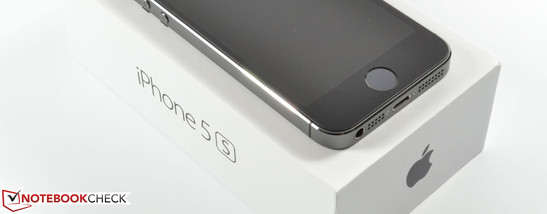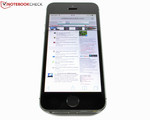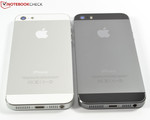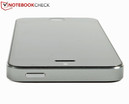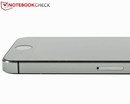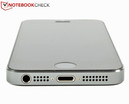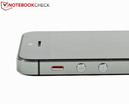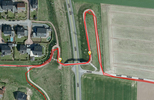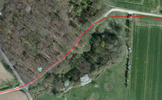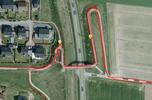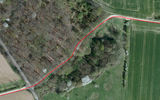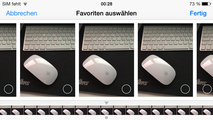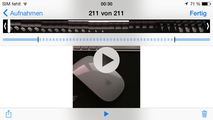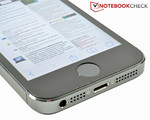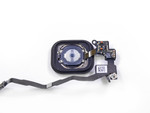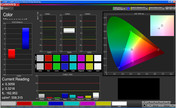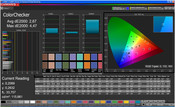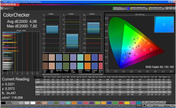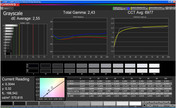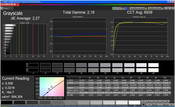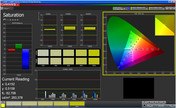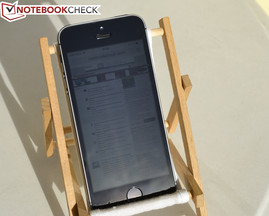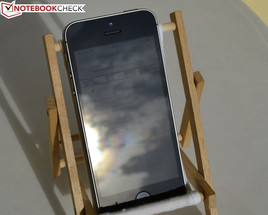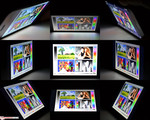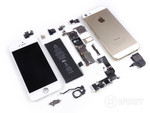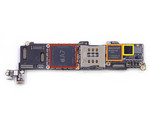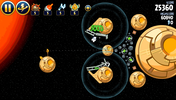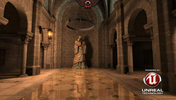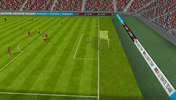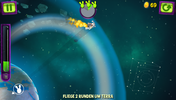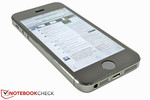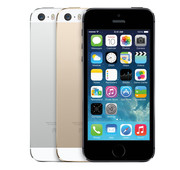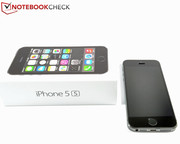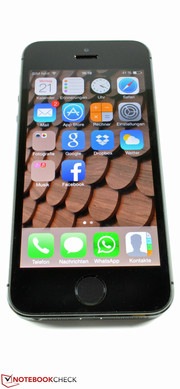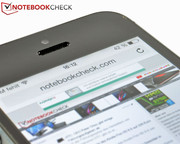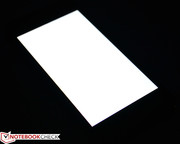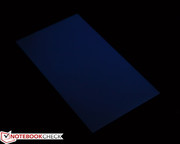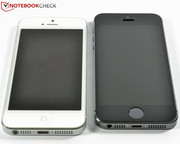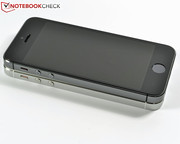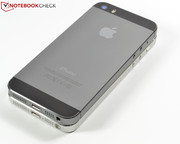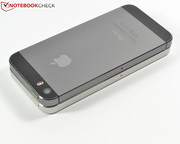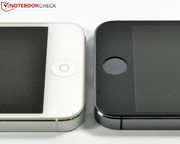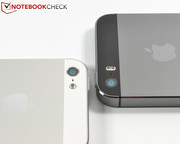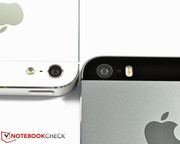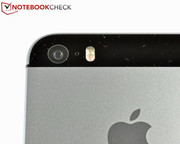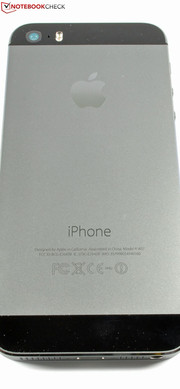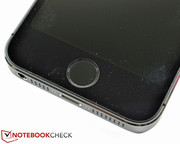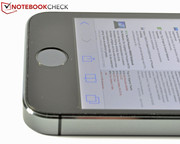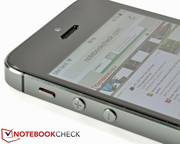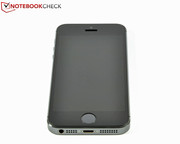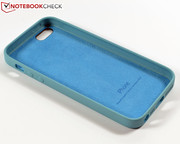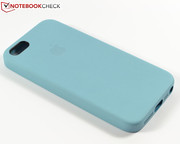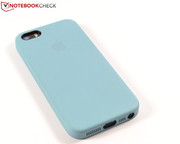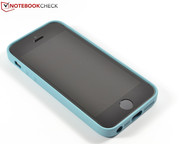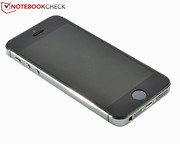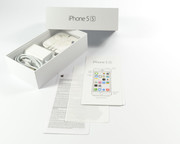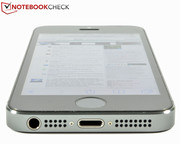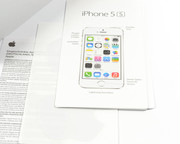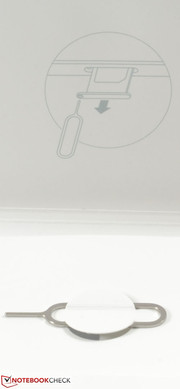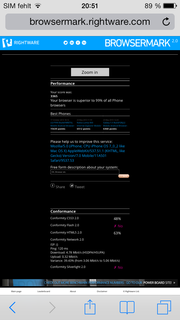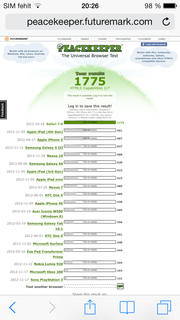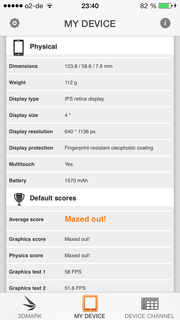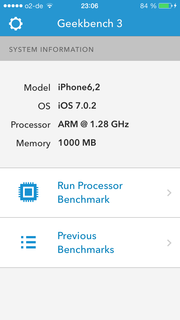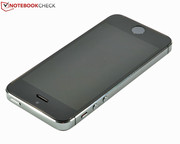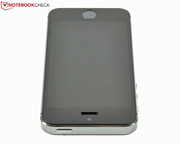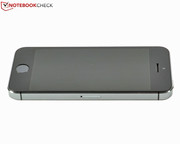Review Apple iPhone 5S Smartphone
For the original German review, see here.
During this year's iPhone event on September 10 in Cupertino, California, Apple has not only presented the colorful new iPhone 5c, but also its newest flagship device, the iPhone 5s. So what is truly new about this phone? Is it worth an upgrade for owners of the iPhone 5?
In terms of design, not much has changed. The chassis remains the same, but instead of white or graphite black, it now comes in "Space Gray" or alternatively in silver-white ("Silver") or gold-white ("Gold"). The IPS display still sports a 4-inch diagonal, and it still comes with 1136x640 pixels, although its peak brightness has been increased slightly. The camera has been somewhat improved and augmented by a dual LED flash. Most notably though, a fingerprint sensor has been integrated into the home button, replacing the conventional version. This comes in handy when unlocking the phone or simply buying (and paying for) AppStore purchases with the push of a finger, without any hassle or use of passwords. Together with the fingerprint sensor, Apple's brand-new A7 SoC with an integrated Imagination PowerVR G6430 graphics solution and the Apple M7 co-processor may very well be the most crucial change. In addition, the integrated LTE chip is now capable of supporting many more frequency bands (e.g. all of those available in Germany). The iPhone 5s ships with the most recent version of iOS, iOS 7.02. As usual, it can be had with a non-replaceable internal storage of 16, 32 or 64 GB. Thanks to a more powerful battery, the new flagship is supposed to offer up to 10 hours of 3G talk time.
The price remains the same, starting at 699 Euros (~$964 RRP) for the 16 GB version without a contract. Our in-depth review will show whether the new device is truly almost twice as fast as its predecessor, checking Apple's statements about the differences between the iPhone 5s and the iPhone 5. In addition, we will compare the new flagship with its direct competitors (which gets stronger and more numerous from year to year). The fiercest fights occur among Android handsets, especially the Samsung Galaxy S4, the HTC One, the Sony Xperia Z1 and the LG G2, which are all pretty much on par with each other. Nokia's Lumia 1020 and the Lumia 925 are two of the best Windows 8 phone devices. Last but not least, the iPhone 5s also has to stand its ground against the in-house competition from the iPhone 5 and the iPhone 5c.
The unibody chassis of the Apple iPhone 5s has remained almost completely unchanged when compared to its predecessor, the iPhone 5 - with the only exceptions being the new dual LED flash next to the rear camera and the revamped Home Button, which now includes a fingerprint sensor. Thus, almost all of the positive and negative impressions in our detailed review of the iPhone 5 still hold true.
There are now more color choices, however. Next to a silver-white hue, gold-white iPhones can be had as well. The black variant (the first batch of which used to ship with a scratch-prone coating) has become a bit brighter, with the color being called "Space Gray". Small black stripes made of glass decorate the upper and lower ends of the back panel. The color coating of our test device seems to be very resilient. Even after prolonged periods of real-life usage, no ugly scratches can be found. As usual with Apple, build quality and materials are top-notch, with no clearances to be found anywhere on the phone.
Even the exact dimensions and the weight have carried over from the iPhone 5: 112 grams (~4 ounces) and a size of 123.8 x 58.6 x 7.6 millimeters (~4.9 x 2.3 x 0.3 inches) are still very good for a 4-inch smartphone made from aluminum.
If there is any aspect where Apple comes up short, it is in terms of ports. Next to the 3.5 mm audio jack and the Lightning Port (both at the bottom of the phone), there is only the Nano SIM card slot at the right. If the user wants to use a micro USB charging cable? It is 19 Euros (~$26) for a Lightning-to-micro USB 2.0 adapter (something that should have been included, given the feeble selection of free accessories). The usual iPhone buttons, ranging from the volume rocker and the mute button on the left to the power button on top are still there, unchanged from the iPhone 5. Only the revamped Home Button with Touch ID is new, but more about that later.
Software
The iPhone 5s ships with the brand-new iOS 7 (our test sample comes with version 7.02 of the operating system, but a number of bug fixes will soon become available with 7.03 to get rid of the initial problems) that was released in September. All further details concerning the major redesign of iOS 7 can be found in our in-depth review of the iPhone 5c.
We are unable to corroborate recent reports that the iPhone 5s crashes significantly more often that the iPhone 5 or the iPhone 5c - it is just as stable as our eternal iPhone 5 test device. Most (but by no means all) app developers have already solved 64-bit transition problems by issuing updates to their apps.
Communication & GPS
As it did with the recently tested iPhone 5c, Apple has built a new wireless modem into its iPhone 5s, capable of supporting more LTE bands than before: Four GSM and five UMTS frequencies should be sufficient to cover most of the world. Again, more details about this can be found in our iPhone 5c review article.
The Wi-Fi module supports the 802.11a/b/g/n standard. It however, does not support the new ac-standard. During our tests, our iPhone 5s had to connect to a router from which it was separated by 10 meters (~33 feet) and three walls. The results are encouraging: Two to three (of three) bars, depending on the exact location in the room, is slightly better than what we see with the iPhone 5, and ever so slightly ahead of the Nokia Lumia 920. The only competitor that trumps the iPhone 5s in this regard is the Blackberry Z10.
Similar to what we did with our reviews of the Samsung Galaxy S4 and the iPhone 5c, we have taken the iPhone 5s on a bicycle ride through agricultural areas, dotted with some forests, letting it compete against a full-blown GPS navigation system made by Garmin. The resulting data points are visualized using the Fitness program Runtastic.
Surprisingly, the GPS module used in the iPhone 5s is even more precise than the already great one in the iPhone 5c - and, at times, far ahead of the competition from Garmin. This may very well be due to Apple's new M7 Motion co-processor as well, since it serves as a sensor hub, constantly interpreting the incoming data collected by the compass, the gyroscope and the acceleration sensor with the help of the Core Motion API of iOS 7. This helps in putting less strain on the A7 SoC, improving battery life in the process. It is actually smart enough to recognize when a driver exits his or her car and continues on foot, switching over to walking mode. In addition, the M7 can also be used to suppress incoming calls or connection attempts as well as distracting pop-up notifications.
The part of the bicycle trip where we crossed the bridge illustrates the great GPS performance of the iPhone 5s. While the Garmin navigation device was more or less guessing our position, resulting in a zigzag pattern, the iPhone 5s comes much closer to the actual route. Neither device fares quite as well in the forest patch, but again, the iPhone 5s stands its ground.
In summary, the GPS module of the iPhone 5s is definitely above average. Even indoors, the precise position of our device is found quickly.
Telephone Functions & Speech Quality
The telephone app works as reliably and intuitively as always. It comes with the same sleek new design language as all other Apple iOS 7 apps. Again, further details can be found in our reviews of the iPhone 5c and the iPhone 5.
In terms of speech quality (on both ends), nothing at all has changed when compared to the iPhone 5 or the iPhone 5c. But this is actually a good thing, as it has been very decent to begin with. Thanks to its active noise suppression system, voice calls can always be understood clearly (again, on both ends), even when talking right next to a construction site.
Cameras & Multimedia
After a first glance at the specs sheet, the two cameras do not seem to have changed very much. The sensor rear iSight camera sports the same 8 megapixels as before (3264x2448), being equipped with autofocus and an LED flash. The latter is now called "True Tone Flash" and comes with two LEDs; one with a warm color temperature and one with cold. In combination, these two LEDs are supposed to yield more natural and pleasant (skin) colors when compared to the iPhone 5 or the iPhone 5c. The sensor has also grown by 15% when compared to these two devices, now sporting 1.5µm pixels as well as an improved maximum aperture of f/2.2. Both new features can lead to noticeable improvements, especially under low-light conditions. As a side effect, the flash is not used as often as before when the camera is set to auto mode - all of this while still resulting in better images. Full HD videos look pleasant and sharp, thanks to the fast image stabilization system.
The panorama mode is as fun as always, but two new functions have been added to the camera as well: Serial exposures and a slow motion mode that produces videos with up to 120 fps. While the latter may or may not be just a gimmick, the former works exceedingly well with next to no latency in between pictures thanks to the fast Apple A7 SoC and its ability to quickly move data to and from the main memory (probably using the DRAM as buffer storage since the Nand Flash storage wouldn't react fast enough). When the trigger is held down continuously, up to 999 photos can be shot as a lightning fast series. Nice: All of these show as just one photo in the gallery app. It is then as easy as pie to choose the ones one wants to keep, with the rest being discarded automatically (the camera app even provides an intelligent pre-selection algorithm, although these are just suggestions and do not have to be followed). All pictures can of course be transferred via USB to a PC or a Mac if it proves too hard to decide right on the device.
Overall, we were quite impressed with the performance of the iSight camera of the iPhone 5s, especially under bad lighting conditions. It is definitely superior to the modules used in the iPhone 5 and the iPhone 5c.
The Face Time camera has remained largely unchanged from the iPhone 5c, having been subtly improved when compared to the iPhone 5. The pixels have grown from 1.75 µm to 1.9 µm, but the resolution (1.2 megapixels, resolution of 1280x720) and the maximum aperture (f/2.4) remain the same. Again, the improvements can best be seen under low-light conditions. Still, the front camera is better suited for self-portraits or video calls via Face Time, not so much for serious photography purposes.
Comparing the rear camera of the iPhone 5s to our reference camera (the Sony A57) leaves quite a bit to be desired, especially in terms of sharpness, but when pitted against other smartphone cameras, the one in the iPhone 5s offers convincing results. The Nokia Lumia 920 looks a bit duller and not quite as sharp and even the Samsung Galaxy S4 (which ships with 13 megapixels) does not pull ahead, due to its more vibrant and thus less natural colors when compared to the iPhone 5s. As can be seen by taking a glance at the stuffed animals in these reference pictures, the iPhone 5s even seems to offer a little bit more sharpness.
Accessories
Same old story: As with the iPhone 5 and the iPhone 5c, Apple's EarPods, a 5V USB power adapter and a 1m (~3 feet) USB-to-Lightning cable are in the box - that is it.
A ton of optional accessories can be purchased, though, from both third-party manufacturers (cables, adapters, covers...) and Apple itself. Among the official products found in any Apple Store are the new leather covers (in several different colors) for 39 Euros (~$54) as well as a dock for around 30 Euros (~$41).
Warranty
As usual, Apple's smartphones ship with a 12-month warranty - which can be doubled in length and increased in functionality with an Apple Care Protection Plan worth 100 Euros (~$138) - and 24 months of legally required defects liability (in the EU).
Input Devices & Handling
Touchscreen & Virtual Keyboard
The capacitive touchscreen of the iPhone 5s works every bit as reliably and precisely as that of the iPhone 5 and the iPhone 5c (actually, it is exactly the same as the one used in the previously tested iPhone 5c, thus more information as well as a video illustrating the new UI of iOS 7 can be found in our detailed review of the iPhone 5s' colorful sibling). The glass surface leads to a pleasant gliding sensation and enables exact, quick input.
Touch ID
Possibly the most interesting new feature of the most recent iPhone flagship (next to the A7 chip and the new camera modules) is the revamped Home Button. In contrast to the concave one used in the iPhone 5 and the iPhone 5c, this one is flat, but recessed. It is surrounded by a ring made from stainless steel, which also doubles as the activator of the fingerprint sensor - the Touch ID will simply not work if the ring is not touched. Under the covering made from sapphire glass, the capacitive 500-ppi fingerprint sensor with 360-degree coverage can be found. Once configured, it can be used in lieu of the entering a code on the lock screen. The only exceptions to this rule: Both a reboot and not having unlocked the iPhone for 48 hours make entry of the personal code mandatory. Another nice thing about the Touch ID is its capability to be used to approve of purchases in the iTunes, iBooks and App Stores without entering the password by simply putting a finger on the Home Button. Configuration is a breeze. After about 30 seconds (per finger) of touching it at different angles the scanned print is hashed and stored in its encrypted form in a dedicated compartment of the A7 SoC without copies being saved to iCloud or other Apple servers, making the whole process pretty much theft-proof. Even third-party apps are not allowed to access one's fingerprint data, at least not yet. Up to five fingers can be stored so that it is possible to let one's family use the phone as well. Still, a pass code is mandatory when the Touch ID is to be used - if only as a fallback in case problems with the fingerprint scanner occur.
Some members of the Chaos Computer Club have apparently managed to hack the Touch ID by copying a fingerprint onto an artificial finger, unlocking the smartphone in the process. They did so in order to point out the potential dangers associated with using biometric data. Moreover, while they are right - it is never impossible to hack fingerprint readers - we are pretty confident that the chances of such a thing happening to an ordinary user are slim to none and that this should not keep Apple's customers from using the new Touch ID.
Our verdict concerning the new fingerprint sensor: While we started out being skeptical about its real-life usability, we have grown to like the idea behind Touch ID thanks to its smooth implementation in iOS 7. We do actually miss this feature a bit when going back to the iPhone 5 after one week of using the iPhone 5s.
The display of the iPhone 5s is closely related to that of the iPhone 5 and the iPhone 5c, sporting an IPS LCD panel with a resolution of 1136x640 pixels, an aspect ratio of 16:9 and a diagonal of 4 inches. While this Retina display may not sound quite as good on paper as the HD (or even Full HD) displays its competitors sport, it is still a more-than-decent screen thanks to its vivid colors, its high peak brightness and its good color space rendition.
Its brightness of 538.4 cd/m² is actually one of the most pronounced strengths of this panel, pulling ahead of the iPhone 5 and the iPhone 5c by approximately 50 cd/m² and 1 cd/m² (537.2 cd/m²), respectively. The latter difference is small and may very well be due to natural fluctuations within a production batch. Still, the iPhone 5s' peak brightness of 579 cd/m² is better than what most competitors offer: While the Sony Xperia Z1 (523 cd/m²) and the HTC One (519 cd/m²) come close, the Nokia Lumia 925 (315 cd/m²), the Nokia Lumia 1020 (310 cd/m²), the Samsung Galaxy S4 (310 cd/m²) and the LG G2 (358 cd/m²) are, although decent in their own right, far behind. Still, it has to be noted that both Nokia Lumia smartphones as well as the Samsung Galaxy S4 make use of OLED displays that, while nominally being darker, still appear relatively bright due to the technology employed.
| |||||||||||||||||||||||||
Brightness Distribution: 88 %
Center on Battery: 579 cd/m²
Contrast: 724:1 (Black: 0.8 cd/m²)
ΔE ColorChecker Calman: 2.76 | ∀{0.5-29.43 Ø4.82}
ΔE Greyscale Calman: 2.55 | ∀{0.09-98 Ø5.1}
Gamma: 2.43
CCT: 6977 K
While the brightness homogeneity of the iPhone 5s of 88% comes close to that of the iPhone 5c, but it actually lags behind that of the iPhone 5 (95%). Fortunately, this can barely be seen with the naked eye. It takes a uniform white background to notice some darkened areas near the borders of the screen. A bigger problem is that the iPhone 5s, despite being the brightest of its field, fares considerably worse than the rest of the gang once it comes down to its black levels except for the 0.9 cd/m² of the Sony Xperia Z1). Blacks are shockingly grayish at 0.8 cd/m² - even its predecessor (0.48 cd/m²) and the iPhone 5c (0.66 cd/m²) are much better, while not even they come close to the LG G2 (0.33 cd/m²) or the HTC One (0.23 cd/m²). The decent black levels of these Android-running competitors are not even the end of the flagpole: OLED displays such as the Samsung Galaxy S4 or the Nokia Lumia 925 and 1020 come close to rendering perfect blacks, with barely measurable values in the vicinity of 0.0 cd/m². Due to the bad black levels, the iPhone 5s only manages to yield a mediocre contrast ratio of 724:1 (again, only the Sony Xperia Z1 fares worse with 561:1). The OLED-based competitors play in a different league entirely.
On the other hand, the Retina display shows its strengths when it comes to our colorimeter measurements, visualized with the help of the CalMAN 5 software. Pre-calibration has been good, especially with regard to color management: All DeltaE values are less than 5, implying just slight deviations from the sRGB reference color space. Color accuracy is thus very good, with just some minor deviations. Even a DeltaE value 4 in the (larger) AdobeRGB color space is a great result. While blue colors have not been discriminated against quite as strongly as it had been the case with the iPhone 5c, no bluish tint could be noted with the naked eye. Grayscale rendition is close to ideal as well, corroborating the sRGB and AdobeRGB results.
One of the most important usability tests of a smartphone display - its outdoor readability - is no problem for the iPhone 5s, thanks to its high peak brightness. Still, reflections cannot be prevented, restricting its usability under certain conditions. Other than that, the screen contents of the iPhone 5s will remain visible at all times.
Since the Retina display once again makes use of IPS technology, its viewing angle stability is superb. Even under extreme (impractical) angles, the screen contents remain readable, with just some minor losses in terms of brightness, but without any color inversions or diminishing contrast ratios. Only the "glowing" of a black background (which is rather typical for IPS displays) attracts negative attention, but this should not be a real concern during actual usage scenarios.
According to Apple, the new Apple A7 SoC with its 1.3 GHz ARMv8-based CPU and integrated PowerVR G6430 graphics chip based on a 64-bit "Cyclone" architecture is supposed to offer twice the performance levels of its predecessor, the A6 used in the iPhone 5. According to the semiconductor specialist Chipworks, the SoC is once again (ironically so) made by Samsung while the Motion M7 co-processor "LPC18A1" (which is based on the ARM Cortex-M3) is produced by NXP. Both utilize a 28 nm process.
The graphics solution Imagination PowerVR G6430 is a 4-cluster chip with approximately twice the performance of the SGX543MP3 of the A6 used in the iPhone 5 and the iPhone 5c.
The results gained from different synthetic benchmarks could not be clearer. Especially during the Geekbench 3 single-core test, the iPhone 5s pulled ahead by up to 50% when compared to the Samsung Galaxy S4, the iPhone 5 and the iPhone 5c (and by 40% in relation to the LG G2). The multi-core score sees the Sony Xperia Z1 taking the lead by 13%, but the rest of the crowd falls behind once again.
Similar results hold true when looking at the Linpack benchmark. Again, the Sony Xperia Z1 takes the lead (barely); again, the rest of the field trails behind (often by 30 to 40%, as do the in-house competitors). The PassMark Performance Test sees the iPhone 5s ahead by up to 36%, even though the competition is not slow at all. In addition, while this might change once more Snapdragon 800-based devices such as the Sony Xperia Z1 appear on the market, for now the iPhone 5s takes a top spot in almost all disciplines. During the Basemark X 1.0 on-screen test, the Samsung Galaxy S4 fares even 70% worse than the iPhone 5s (to be fair, it has to power a lot more pixels), with the Sony Xperia Z1 coming in at 30% less. Taking a look at the GFXBench 2.7 off-screen results, the Sony Xperia Z1 comes closer again (8% slower), as does the LG G2 (20%), but the difference between the iPhone 5s and the iPhone 5c jumps to 73%. Due to the iPhone 5s' low screen resolution, its dominance is even more pronounced when comparing the on-screen results: It yields 35% (Sony Xperia Z1) to 84% (Nokia Lumia 1020) better performance than the competition.
The 3DMark Ice Storm benchmark actually did not even produce measurable values (maxed out!). The same holds true for the Ice Storm Extreme test (due to some parts of the tests being maxed out, no overall result could be given). The Unlimited Test reveals performance levels which almost rival those of the Sony Xperia Z1, coming even closer to its Snapdragon 800-based competitor during the Graphics test.
| Linpack Android / IOS - Multi Thread (sort by value) | |
| Apple iPhone 5S | |
| Apple iPhone 5c | |
| HTC One | |
| Apple iPhone 5 | |
| LG G2 | |
| Samsung Galaxy S4 GT-I9505 | |
| Sony Xperia Z1 | |
| Geekbench 3 | |
| 32 Bit Multi-Core Score (sort by value) | |
| Apple iPhone 5S | |
| Apple iPhone 5c | |
| LG G2 | |
| Samsung Galaxy S4 GT-I9505 | |
| Sony Xperia Z1 | |
| 32 Bit Single-Core Score (sort by value) | |
| Apple iPhone 5S | |
| Apple iPhone 5c | |
| Apple iPhone 5 | |
| LG G2 | |
| Samsung Galaxy S4 GT-I9505 | |
| Sony Xperia Z1 | |
| (sort by value) | |
| Apple iPhone 5S | |
| Apple iPhone 5c | |
| Apple iPhone 5 | |
| LG G2 | |
| Samsung Galaxy S4 GT-I9505 | |
| Sony Xperia Z1 | |
| 3DMark | |
| System (sort by value) | |
| HTC One | |
| Apple iPhone 5 | |
| Samsung Galaxy S4 GT-I9505 | |
| 1920x1080 Ice Storm Extreme Score (sort by value) | |
| Apple iPhone 5S | |
| Apple iPhone 5c | |
| LG G2 | |
| Samsung Galaxy S4 GT-I9505 | |
| 1920x1080 Ice Storm Extreme Graphics (sort by value) | |
| Apple iPhone 5S | |
| Apple iPhone 5c | |
| LG G2 | |
| Samsung Galaxy S4 GT-I9505 | |
| 1920x1080 Ice Storm Extreme Physics (sort by value) | |
| Apple iPhone 5S | |
| Apple iPhone 5c | |
| LG G2 | |
| Samsung Galaxy S4 GT-I9505 | |
| 1280x720 offscreen Ice Storm Unlimited Physics (sort by value) | |
| Apple iPhone 5S | |
| Apple iPhone 5S | |
| Sony Xperia Z1 | |
| 1280x720 offscreen Ice Storm Unlimited Graphics Score (sort by value) | |
| Apple iPhone 5S | |
| Apple iPhone 5S | |
| Sony Xperia Z1 | |
| 1280x720 offscreen Ice Storm Unlimited Score (sort by value) | |
| Apple iPhone 5S | |
| Apple iPhone 5S | |
| Sony Xperia Z1 | |
| GFXBench (DX / GLBenchmark) 2.7 | |
| 1920x1080 T-Rex Offscreen (sort by value) | |
| Apple iPhone 5S | |
| Apple iPhone 5c | |
| Nokia Lumia 1020 | |
| Nokia Lumia 925 | |
| Apple iPhone 5 | |
| LG G2 | |
| Samsung Galaxy S4 GT-I9505 | |
| Sony Xperia Z1 | |
| T-Rex Onscreen (sort by value) | |
| Apple iPhone 5S | |
| Apple iPhone 5c | |
| Nokia Lumia 1020 | |
| Nokia Lumia 925 | |
| Apple iPhone 5 | |
| LG G2 | |
| Samsung Galaxy S4 GT-I9505 | |
| Sony Xperia Z1 | |
All browser-based benchmarks have been performed within the most recent version of Safari on iOS 7.02. Again, the iPhone 5s crushes most of its competitors (sometimes by a huge margin). During the Google Octane V1 test, the two Windows phones Nokia Lumia 925 and Nokia Lumia 1020 trail 90% behind. Again, only the Sony Xperia Z1 comes close, yielding 25% less points than the iPhone 5s.
| Octane V1 - Total Score (sort by value) | |
| Apple iPhone 5S | |
| Apple iPhone 5c | |
| HTC One | |
| Nokia Lumia 1020 | |
| Nokia Lumia 925 | |
| Apple iPhone 5 | |
| LG G2 | |
| Samsung Galaxy S4 GT-I9505 | |
| Sony Xperia Z1 | |
| Browsermark - --- (sort by value) | |
| Apple iPhone 5S | |
| Apple iPhone 5c | |
| HTC One | |
| Nokia Lumia 1020 | |
| Nokia Lumia 925 | |
| Apple iPhone 5 | |
| LG G2 | |
| Samsung Galaxy S4 GT-I9505 | |
| Sony Xperia Z1 | |
| Peacekeeper - --- (sort by value) | |
| Apple iPhone 5S | |
| Apple iPhone 5c | |
| HTC One | |
| Nokia Lumia 1020 | |
| Nokia Lumia 925 | |
| Apple iPhone 5 | |
| LG G2 | |
| Samsung Galaxy S4 GT-I9505 | |
| Sony Xperia Z1 | |
| Mozilla Kraken 1.1 - Total (sort by value) | |
| Apple iPhone 5S | |
| Apple iPhone 5c | |
| Nokia Lumia 1020 | |
| LG G2 | |
| Sony Xperia Z1 | |
* ... smaller is better
Games
The PowerVR G6430 graphics solution within the A7 SoC is more than capable of handling all games, which can be purchased in the App Store, even supporting the highly demanding OpenGL ES Ver. 3.0 engine. 2D applications such as Rabbids: Big Bang or Angry Birds: Star Wars are no challenge at all, but even 3D games such as Infinity Blade 2, FIFA 14 or Asphalt 8 run smoothly and with maximum details, as does Epic Citadel, a demanding graphics demonstration. There should even be enough reserves to handle all the upcoming, 64-bit optimized games with their "next-gen" graphics.
Temperature
The surface temperatures of the iPhone 5s always remain comfortable during real-life usage scenarios, not even exceeding 31.2 degrees Celsius (88.16 Fahrenheit) during low-level use (which comes close to a typical "idle" state).
Even under full load during the stress test (Epic Citadel demo for CPU and GPU, running continuously for at least one hour), the smartphone does not get truly hot. Locally, 39.5 degrees Celsius (103.1 Fahrenheit) can be reached, but on average, no more than 36.6 degrees (97.88 Fahrenheit) on the back and 36.2 degrees (97.16 Fahrenheit) on the front were measured. Thus, excessive gaming sessions should not be a problem. And, to make things even better: The power adapter remains at least just as cool, staying below 32.9 degrees (91.22 Fahrenheit) under full load. Overall, this is an exemplary performance of the iPhone 5s in terms of heat emissions, never getting alarmingly hot.
(+) The maximum temperature on the upper side is 39.5 °C / 103 F, compared to the average of 35.2 °C / 95 F, ranging from 21.9 to 247 °C for the class Smartphone.
(+) The bottom heats up to a maximum of 37.6 °C / 100 F, compared to the average of 33.9 °C / 93 F
(+) In idle usage, the average temperature for the upper side is 28.3 °C / 83 F, compared to the device average of 32.9 °C / 91 F.
Speakers
The speakers of the iPhone 5s are every bit as good as those of the iPhone 5c and the iPhone 5. Again, more details can be found within these two in-depth reviews.
Power Consumption
The iPhone 5s consumes approximately as much (or, in this case, as little) power as the iPhone 5c and the iPhone 5. Under full load, 0.5 Watts more are needed than was the case for the iPhone 5c, but this is to be expected due to the much more powerful SoC and the brighter screen. Most high-end competitors are thirstier by far than the iPhone 5s, with the main exception being the HTC One.
While idle, the iPhone 5s requires somewhat more power than expected (again, probably due to the brighter screen). Still, 0.6 to 1.6 Watts are by no means problematic. Those who have used an iPhone 5 with iOS 6 before will probably long for those better battery runtimes. It is, however, very well possible to reduce iOS 7's hunger by deactivating background animations and background updates as well as limiting Spotlight search.
| Off / Standby | |
| Idle | |
| Load |
|
Key:
min: | |
Battery Life
At least, the battery size has been increased by 5 or 10%, from 5.73 Wh (iPhone 5c) or 5.45 Wh (iPhone 5) to 5.96 Wh.
Under full load, the iPhone 5s only manages to squeeze 5 more minutes of running time out of its larger-sized battery (when compared to the iPhone 5c). Again, this is most likely due to the more powerful SoC and the brighter display. Fortunately, our impression from our review of the iPhone 5c - namely that the battery life seems to suffer over proportionally in relation to the power consumption rate when less demanding tasks are to be performed - only partially holds true. While the iPhone 5s survives for approximately 4 hours less than the iPhone 5c during our Wi-Fi browsing test, the opposite is true while both phones are being idle, with the iPhone 5s' 22 hours (almost iPhone 5 territory again!) beating the 19 hours of its colorful sibling.
Note: Our Wi-Fi browsing test crashed repeatedly on both our test device and the iPhone 5 when opening a certain website (without the reasons for this becoming immediately apparent). Thus, we had to reopen the browser app every 5 minutes, something that is certain to cost an excess amount of power. Thus, the resulting 10 hours are probably too conservative a value - we would not be too surprised if 13 to 14 hours (close to the result of the iPhone 5c) were a more realistic result.
When compared to its competitors, the iPhone 5s still fares decently, especially when its smallish battery is taken into account. After all, both the HTC One (8.74 Wh / 2300 mAh) and the Nokia Lumia 1020 (7.6 Wh / 2000 mAh) failed to yield more than 11 hours of battery life as well, and the Samsung Galaxy S4 (9.88 Wh / 2600 mAh) - hampered by its blacks-loving OLED display - barely managed to survive for 9 hours of continuous web browsing. On the other hand, both the Sony Xperia Z1 (3000 mAh) and the Nokia Lumia 925 (8.4 Wh / 2000 mAh) fare better than the iPhone 5s, with 13 and 15 hours, respectively. But no (flagship) phone beats the LG G2 (11.4 Wh / 3000 mAh) and its unbelievable 17 hours of web browsing. Under full load, the iPhone 5s remains more or less on par with most of its competitors, its 2:50 hours only being crushed by the LG G2 (3:40 hours) and the Samsung Galaxy S4 (3:50 hours).
Verdict
The Apple iPhone 5s is a successful refresh of the iPhone 5. In terms of design, it has remained largely unaltered, with the exception of the Touch ID fingerprint sensor, which is not obligatory but can be a useful and reliable addition to the overall smartphone experience. The redesigned camera modules and the new dual LED flash have helped lead to a notable improvement in terms of image quality. The fast Apple A7 SoC with the Imagination PowerVR G6430 leads to great application performance, not the least thanks to the meaningfully employed 64-bit architecture. The new iOS 7 is intuitive and feels like fun during actual usage. Speech quality is as good as it always was, as is the external speaker (despite being mono only). The GPS module is surprisingly good, even beating some dedicated navigation systems. Last but not least, the Wi-Fi module also gets its job done.
However, although the sharp, bright and well pre-calibrated Retina display is still a sight to behold, an update in terms of size and resolution is desperately needed by now. In addition, both the black levels and the contrast ratio should be better for such a pricey device. NFC is still missing, but at least more LTE bands than ever are supported (including all of those used in Germany).
To summarize, Apple's iPhone 5s remains an eye-catching device, and in more ways than before, as the premium gold variant shows. It also remains premium in terms of price, starting at 699 Euros (~$964) for the 16 GB version that we have tested - quite a considerable amount of money. Still, it is a high-end device. As usual, it is one of the fastest smartphones out there (with the Sony Xperia Z1 being the only competitor right now, although more Snapdragon 800 devices will follow), but it is more and more sorely lacking in terms of its screen size. For the next iteration of iPhones, we are - as usual - hoping for more true innovation, more highlights and more courage from Apple.




